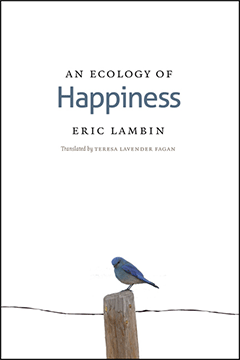By Germaine Cornelissen-Guillaume
That we are influenced by our environment is undeniable. That we, in turn, impact our environment is a concept we only recently became more aware of, following Vernadsky’s proposition that life is the geological force that shapes the earth. With Edouard Le Roy and Teilhard de Chardin, this idea became known as the “noosphere” (sphere of the human thought). Eric Lambin’s book brings the discussion a step further by viewing the problem from a new angle. To the usual question of the impact of human activity on the natural environment, the book addresses the complementary question of the impact of environmental changes on human well-being. This question is crucial to the author in order to mobilize people to assist in a successful transition toward sustainable development. His tenet is that promoting the advantages of a protected natural environment for the multiple purposes of happiness, health, and security is more likely to generate a positive, constructive involvement from the majority of people than a policy of fear. An ecology of happiness attempts to understand environmental conditions that are conducive to happiness.
With E.O. Wilson, Lambin recognizes our innate need for a connection with nature, the living world, and natural processes. He reviews how human interactions with the animal world are an effective approach to staying connected with nature. Domestic animals have a positive effect on health, as does a reduction in dietary meat consumption, beyond the added considerations of the negative footprint that intensive animal farming has and the harsh conditions farm animals live in. The emergence of many new infectious diseases, vector-borne diseases in particular, linked in part to changes in the natural environment caused by human activity, threaten the world economic system and international security. The role played by globalization and urbanization on the degradation of our environment is further reviewed, drawing from case studies in Africa, Europe and North America.
Two recurrent themes deal with separation: separation between rich and poor countries, the latter bearing the brunt of environmental change and the unequal distribution of resources; and in the former, the separation between humans and nature. To reconcile happiness with environmental integrity, Lambin lists five choices for the future: between materialism and a more authentic and sustainable happiness; between an urban culture and emphasis on biophilic tendencies; between a dominating and a mutually beneficial interaction with animals; between a globalization that amplifies social inequalities and one that promotes a sustainable development; and between an egocentric attitude and altruism for the common good. The realization that economic growth does not necessarily correlate with happiness is a strong argument for the transition toward sustainable development.
Based on success stories from three countries, Lambin shows that the paths leading to sustainable development can be quite diverse. Vietnam’s high rate of economic growth through modernization translated into social progress and reforestation, albeit at the cost of increased pollution and import of wood from neighboring countries. Costa Rica’s ecotourism benefited from a government program of payment for ecosystem services that helped preserve one of the richest areas of fauna and flora in the world and maintain a rich biodiversity, but it was more difficult for farmers with smaller lands to participate in the program, risking fragmentation of the natural habitat needed to sustain a high level of biodiversity. Bhutan’s pursuit of “gross national happiness” ahead of the GNP aims at cultivating a responsible form of happiness, a “middle path” between materialism and spirituality, but global warming poses a particular threat to the country, located in the eastern part of the Himalayas, depending on the melting of the snow each year for the production of hydroelectrical energy.
This is not just another book on climate change or on the negative impact of deforestation, land degradation, agricultural expansion, and intensification; or air, water, and ground pollution; or loss of biodiversity. It is so much more. It is a novel approach to an important problem, and the author offers an original perception that is by far more appealing than the more customary fear mongering.
Germaine Cornelissen-Guillaume is a professor of integrative biology and physiology and Director of the Halberg Chronobiology Center at the University of Minnesota, Twin Cities.




